The Foodbuzz list, that is. I made it on to the Foodbuzz Top 9 list today. WOO. to the HOO! I may have to start asking you to go vote for me, cuz I like the spotlight!
You can click on the picture to be directed to the site or just click on any of my Foodbuzz widgets. Go and vote for me!
Cookingly (and slightly grinningly) yours,
Anamaris
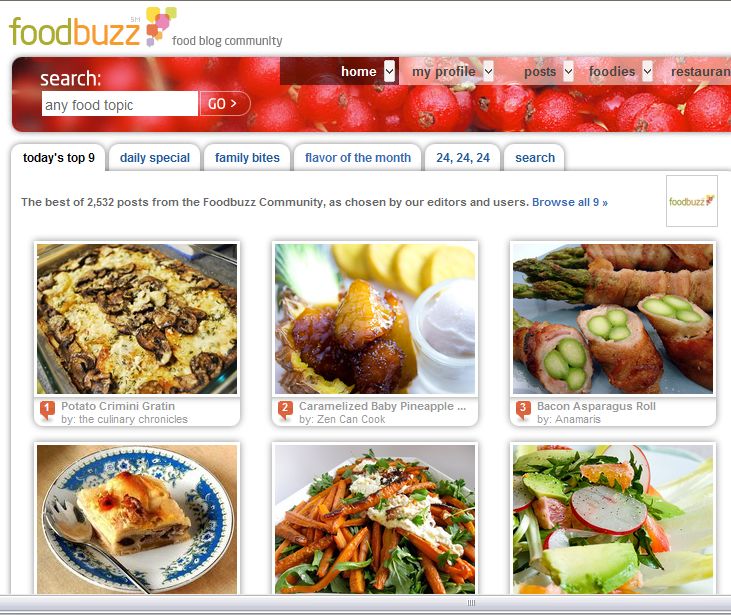
Flan, how I love thee. Let me count the ways. Flan de vainilla. Flan de coco. Flan de queso. Flan de chocolate. Flan de caramelo. Flan. Flan. Flan. Flan! The mere word brings a smile to my lips and conjures up childhood memories when Mom would whip up a batch of Flan Royal (the national brand). Yummy goodness.
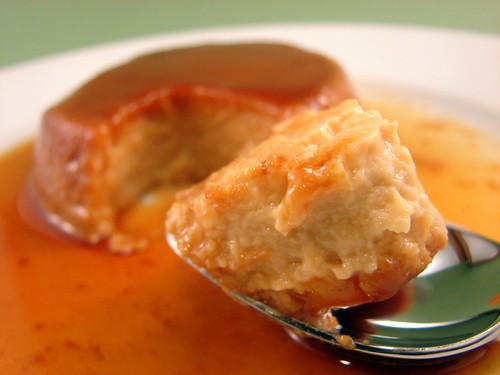
This is one of those really easy desserts that makes a BIG impression. I thought I would share my version of cheese flan with you. I like the custard to be smooth, but not terribly eggy. This recipe does just that. I also add almond extract and, when I have some in my bar, Amaretto. But I didn’t this time, so there isn’t any in this. Still, it was so yummy!
On this occasion I cooked them in a large muffin pan because I wanted to present them individually. However, I usually bake it in a 9-inch baking container and slice it. You can do it either way, of course the baking time will vary slightly.
Flan de Queso
For the caramel sauce:
1-1/4 cp sugar
For the flan:
4 whole eggs
2 egg yolks
4 oz cream cheese
1 tsp almond extract*
1/2 tsp vanilla extract
2 tbsp brown sugar
3 tbsp granulated (white) sugar
1/4 tsp sea salt (bit less if using regular salt)
2-1/2 cps whole milk
Preheat oven to 350°. Prepare a Bain-Marie: you will need a baking pan that is large enough to hold the dish you’re baking the flan in. Add hot water to the large pan and place in the oven.
Make the caramel: add the sugar to a medium, heavy-bottomed pan and put it over medium high heat. Once the sugar begins to melt, lower the temperature to 1 or 2 notches.

At this point, turn down the temperature 1 or 2 notches, you want the sugar to dissolve, but not burn. Burnt caramel is no bueno.

Make sure all the lumps created when stirring have dissolved before you add the caramel to the baking dish(es). Be VERY careful with this sugar. I don’t think I’ve had a burn more painful than that of a caramel burn. Don’t multi-task here.
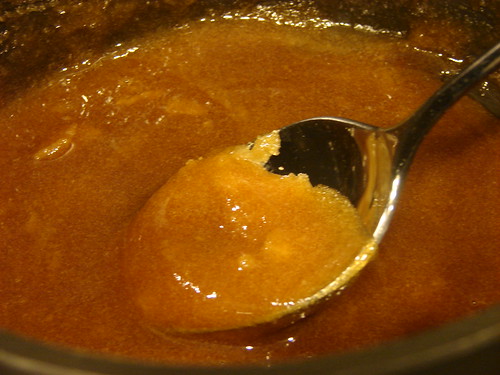
When you have smooth, dark caramel, pour into the dish and swirl it around to coat as much of the cooking surface as possible. Set aside and allow it to cool. It is best for the caramel to cool completely before adding the flan mixture–but DON’T refrigerate it to accelerate the cooling process or you’ll end up with cracked caramel and the custard will seep through it.
Making the custard: Put all the ingredients except for the milk and brown sugar in a blender glass and whisk until smooth. To avoid foaming the eggs, do this by pulsating instead of letting the blender go for a long time. It shouldn’t take more than 5-6 pulses.
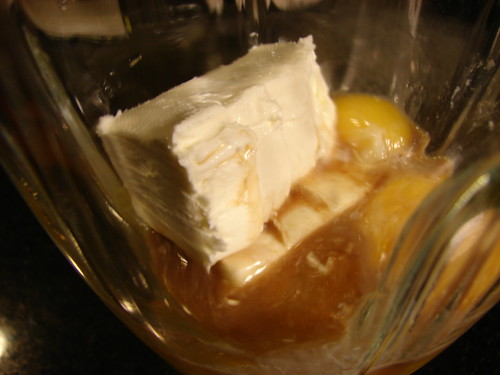
In the meantime, use the same saucepan you made caramel to scald the milk. There will probably be some caramel stuck to the pot. That’s fine, just add the milk and brown sugar and simmer until you see bubbles beginning to form around the edges. Turn off and remove from the heat.
You will now incorporate the hot milk into the egg mixture, because the milk is pretty hot, start the blender on low and slowly drizzle in the milk/sugar mix. As soon as all the milk is added, turn off the blender. Pour the custard into the carameled baking dish. Place the dish with the custard into the pan with water.
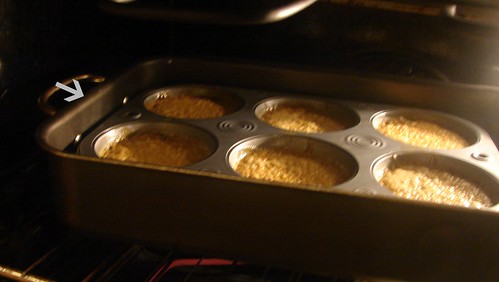
larger pan holds water and baking dish
The muffin-sized flan baked for 25 minutes, if you bake it in a 9-inch dish, it will probably be in the oven for close to 45 minutes. You’ll know it is ready when the top is golden and it begins to separate from the sides. Remove from the oven and allow it to cool at room temperature for about 30 minutes, then put it in the fridge to cool it all the way through.
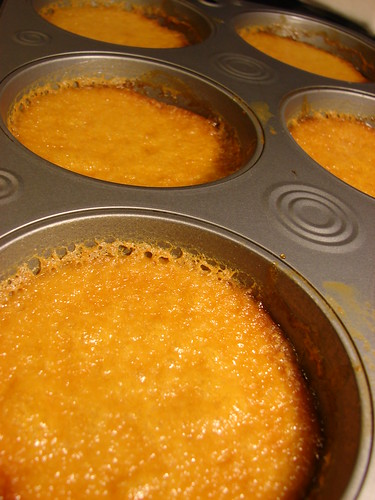
When you’re ready to serve, run a table knife around the edge to help loosen the cooled flan. Then invert it onto your serving dish. To serve the individual ones, I loosened the target cup and placed plastic wrap and foil over the ones to keep them in place. Make sure you invert over your sink, you’ll be amazed at how much of that caramel melts away onto your serving dish.
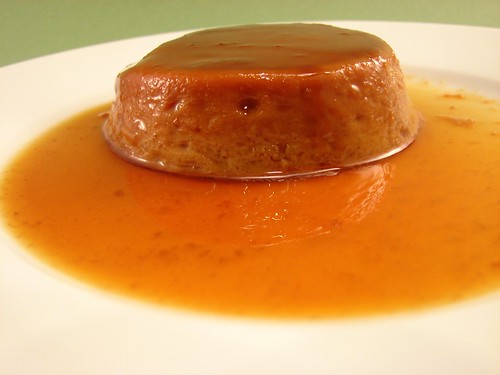
Make sure to serve it chilled and… ENJOY!
Cookingly yours,
Anamaris
*Note: If you are not an almond flavor lover, you can skip the almond extract and increase the vanilla to 1 tsp.
Roux and the White Gravy.
Thanks for coming back for another tip or trip in the Chef School corner. This time we’ll take a look at Roux. This is the base behind a number of sauces, as well as most gravies. A roux will help thicken any sauce and add more depth of flavor.
A roux will be lighter or darker depending on the type of sauce you plan on creating. Lighter roux can easily be made with butter, however, if you plan on a dark sauce/gravy, it may be best to use fat with a higher smoking point. a vegetable, you will cook your roux
Making a Roux
In a medium pan, heat the fat over medium heat. Then add flour. The ratio is 1:1, although bumping the flour a bit can be helpful and lowers the fat content. So, for every tablespoon of fat add 1-1/2 tablespoon of flour. Using a whisk incorporate the flour into the fat. Keep whisking until it reaches the desired color. The objective at this point is to cook the flour, that’s why the temperature shouldn’t be too high.
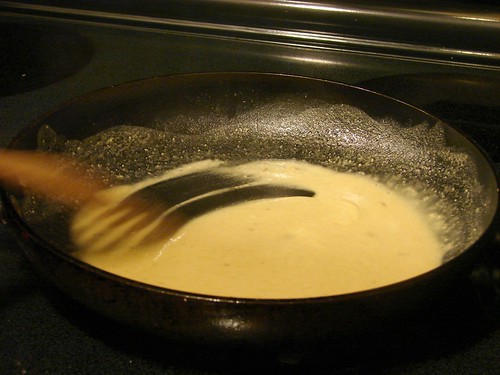
That’s it.
If you decided to make a gray with this roux, be mindful not to add hot liquids, instead, add broth, water or milk that is at room temperature or warm. Also, add them a little at a time, making sure to stir vigorously to avoid creating lumps in the gravy. Also remember that in order to achieve its full thickening potential, you must allow the sauce to boil lightly before turning it off.
I made a white gravy with the roux. I started out with bacon fat, about 2 tablespoons and 3 tbsp of flour. I cooked the flour until lightly golden, about 5 minutes, then added about 2 cps of whole milk.
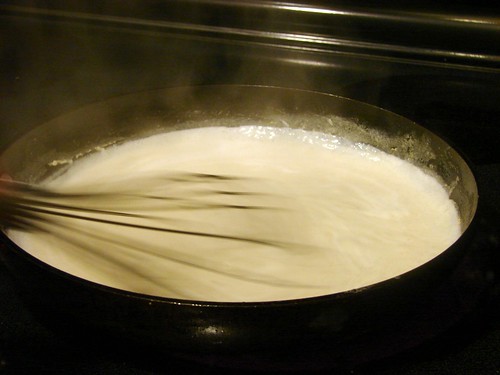
Once thickened, I seasoned it with sea salt, freshly ground pepper and a dash of nutmeg. It became the background for my Bacon & Asparagus Gravy. It was delicious!
There’s more! I’ll tell you in a minute, first, humor me.
I was down to the last chicken breast I purchased for the V-Day recipes and I didn’t know what to do with it. I had the chicken and some asparagus left. You may remember I mentioned not preferring chicken breast. I find it dull, dry and almost flavorless. What can I say? I’m a dark meat kinda girl.
But, I had a chicken breast leftover. As I drove home from work, I kept pondering my options. It wasn’t enough for Hubby’s yummy chicken tenders. Scratch. I’m trying to keep my carb intake down, so adding it to pasta was not an option. Scratch that too. But something with a crunch is what my brain wanted. Then, lightbulb! How ’bout Chicken Fried Chicken(ish), Gravy and Asparagus.
I came up with Chicken Fried Chicken with Asparagus and Bacon Gravy. Don’t ask me how that happened, but you’ll be glad it did! Here’s the awesome recipe.
Chicken Fried Chicken
For the chicken:
1 chicken breast, skinless & boneless
1 tbsp extra virgin olive oil
1 tsp sea salt
1 tsp black pepper
1 clove garlic, crushed
1/2 tsp Herbs d’Provence
1-1/2 cps panko crumbs
Let’s make that lonely chicken breast multiple, shall we? Butterfly that breast, why don’t you! The idea is to split the breast in half and even it out. Make sure your knife is very sharp. Carefully work the knife through the breast, you now have 2 halves.
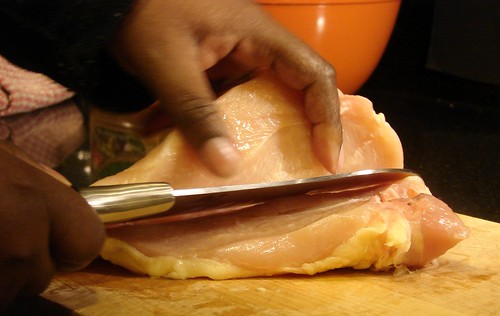
Now that it’s butterflied, you will need to even out the thickness. Cut 2 sides of a large ziploc bag. Lay the breast down on one side of the bag, top it with the other end then use a mallet or a flat heavy pan to flatten the breasts out. This is also known as Paillard.
This is what it looks like before:

And this is it after:

Now that the chicken breast has been thinned out, combine the oil, S&P, garlic and Herbs dProvence in a bowl and add the breast meat. Spin it around to coat all sides and set aside.

For the Bacon Asparagus Gravy:
3 slices bacon, finely chopped
Bacon drippings, about 2 tbsp
3 tbsp flour
10 asparagus spears, chopped
2-1/2 cps whole milk
Sea salt & Fresh pepper
Dash of nutmeg
Brown the bacon in a medium pan. Once golden brown, remove the bacon to a bowl. Drain out most of the drippings, but do not discard the fat, you will need it to make the gravy.
After you’ve peeled and trimmed the asparagus, cut them to pieces that are about 1-inch long. Heat the pan you cooked the bacon in and add the asparagus, throw in a pinch of salt and pepper. Toss the asparagus around a few times, then cover with a tight-fitting lid. Allow it to cook for about 2-3 minutes, just until the asparagus is al dente. Remove and add to the bowl with the bacon. Set aside.

In that same pan, add the rest of the bacon fat over medium heat. When it is hot, add the flour and stir with a whisk. You’re now making a roux. This is a white gravy, so the flour shouldn’t brown. However, in order to improve the taste of the gravy, you need to make sure the flour is cooked. The color should be that of light honey.

Once the roux is the right color, slowly begin to add the milk. Make sure you’re stirring while you add the milk or you’ll end up with lumps. Once all the milk has been added, continue stirring and allow it to come to a boil.

Once it boils, lower the temperature and stir some more until it thickens. When it reaches the consistency you’re looking for, add the asparagus and bacon. Taste and adjust the seasonings as necessary. Set aside.

Now is time to cook the chicken. In a medium skillet, heat enough vegetable oil to cover the bottom of the pan. Spread out the panko crumbs on wax paper and dip the chicken pieces in it. Once the oil is hot, fry the chicken pieces to a golden brown. Remember the chicken is very thin now and will not need to cook for long, probably 2 minutes per side. Remove and drain.
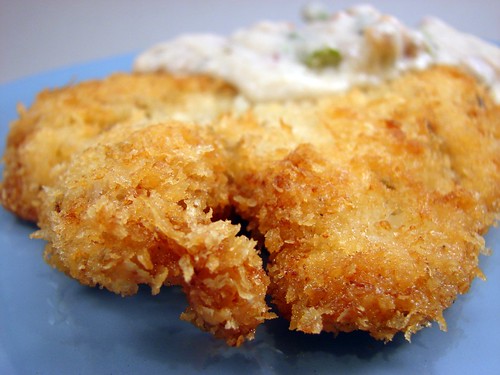
To plate, place a piece of chicken on a plate, then add the gravy right next or on top of the chicken. Enjoy it!

Cookingly yours,
Anamaris

I love food. Food is delicious. I’m fascinated by clever people who can think up even more clever combinations. Food is good. Food is delicious. Sometimes food is also GORGEOUS.
I came across a delightful appetizer on a blog called Palachinka. The hubby and I stared at the pictures for about an hour. Drooled the whole time. We had to have them. So we did. And, yes. They were beautifully. They.were.delicious.
I tweaked the recipe a bit, I wasn’t sure I wanted to use bay leaves. Instead I wanted to play up the sweetness of the pears, so I went for sweet aromatics.
 Blue Pears
Blue Pears
4 pears
2 cps white wine
2 star anise pods
10 black peppercorns, bruised
Vanilla bean pod, about 2-inches
Lemon juice
8 slices bacon, thick
4 oz Bleu cheese, approximately
In a medium saucepan, combine the wine with 2 cps of water, the anise, split vanilla pod and peppercorns. Bring it to a boil, then lower the temperature. Meanwhile, peel the pears, but make sure to keep the stems on. Rub the pears with a bit of lemon juice as you go, that way they will not change color.

Once the poaching liquid has come to a boil, drop the pears in the pan and allowing the simmer for about 20 minutes. Turn off the heat and allow them to cool for about 10 minutes in the liquid. Then remove and drain them.

When the pears are cool enough to handle, cut the top of each pear, about 1-1/2 inches into the pear. Set the tops aside. If you have an apple corer, use it to remove the seed pods. I don’t have one, so I used a small paring knife to cut around it, then scooped it out with a small fork.

Fill the holes with crumbled cheese. I found a delicious Italian Bleu, it was slightly brinier than the usual Bleu, almost like a cross between a Bleu and Feta cheese. Don’t overstuff the pears, but do be generous. Replace the tops on each pear and secure them with a toothpick. If the pears aren’t stable, trim a bit of the bottom to make sure they stand on their own.

Preheat oven to 400°. Stretch the bacon out on a cutting board, particularly if you’re using thick-cut bacon. This way you can thin it out and make it more pliable. Now wrap each pear with 1 or 2 slices of bacon, depending on the size of the pear and the length of the bacon. I only needed 1 slice per fruit. Again, use a toothpick to secure the bacon to the pear.
Line a baking sheet with parchment paper and the place wrapped pears on it. Bake for about 20 minutes. Remove and let them sit for a bit, but do serve them warm.
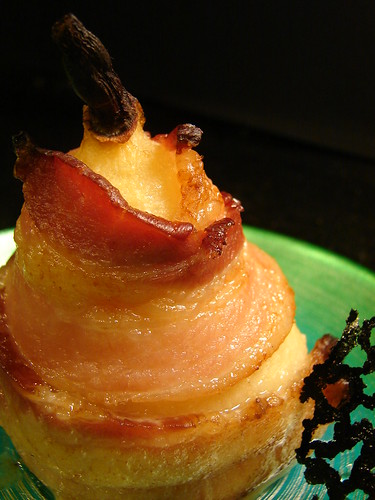
How pretty is that?! Did I mention delicious too?

Cookingly yours,
Anamaris
Not really a vegetable, more of a root or tuber, but definitely a great ingredient for side dishes. I love to combine them with bacon of course, onions and butter. In no particular order.
This is one of my favorite ways to put them together. Quick, easy and delicious.
Onion Potato Casserole
5 medium potatoes, peeled
1/2 large sweet onion (a 1015 or similar)
1-2 tbsp extra virgin olive oil
Sea salt
Black pepper
Slice the potatoes into very thin slices. If you have a mandolin, use the #2 setting. While you work on the onions, submerge the potatoes in cool water to avoid oxidation.
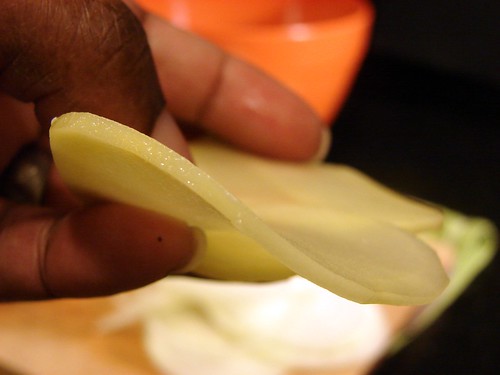
Do the same with the onions, slice them into very thin slices. Separate the onion rings and set aside.
Preheat oven to 375°. Generously butter an ovenproof dish, I used a pie pan. Make sure the butter covers the bottom and sides of the dish. Begin layering the potatoes and onions. First, a single a layer of potatoes, try not to overlap them too much.
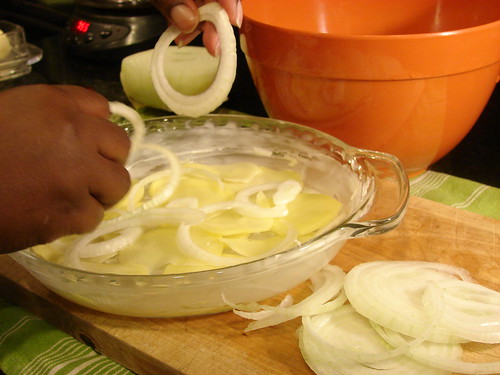
Sprinkle a bit of salt and pepper, then add another layer of potatoes and onions, finishing with potatoes.
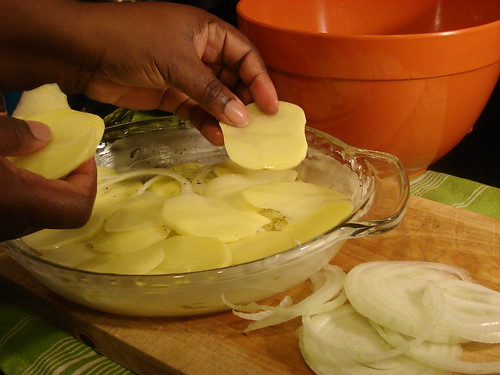
On the last layer, top with salt & pepper, then drizzle the olive oil evenly.
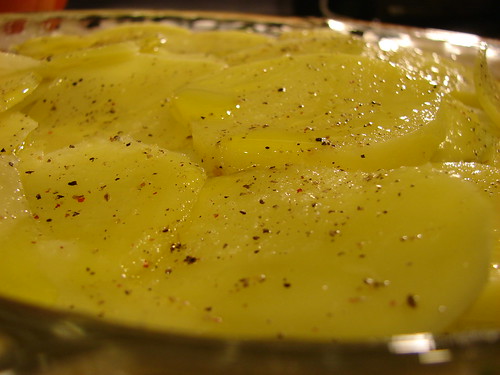
Cover with foil paper and bake it for 20 minutes. A the end of that time, remove the foil, raise the oven’s temperature to 400° and bake for another 15 minutes.
Check out the pretty colors.
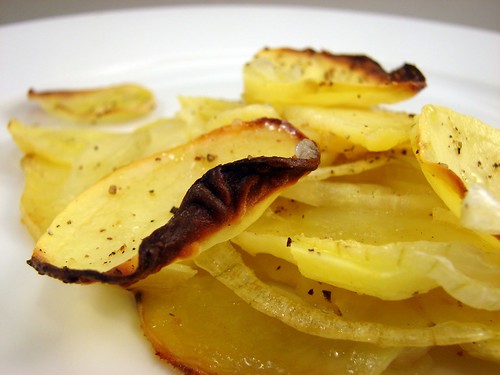
Sides can be daunting. Veggies can be… y’know. Green. And if that’s not your favorite color, then they’re a drag. As I’ve gotten older, grown up, I’ve developed an appreciation for certain veggies. I’ve actually come to LOVE some of them. Asparagus definitely fall in that very small percentile. I L.O.V.E.me some asparagus.
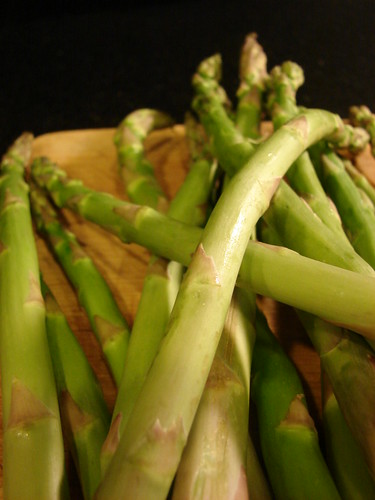
A few months back I was watching a travel show, I think it was Samantha Brown in SF. She was showcasing a cooking school in town. This was the first time I saw asparagus rolled in prosciutto. These days I see it almost every time someone is making asparagus. Nonetheless, I thought it was an awesome idea and couldn’t wait to give it a try.
However, the more I thought about it, I felt the prosciutto may just dry out. That, in my book, is a serious offense against pork. Alas! Lightbulb moment. Sub prosciutto for bacon and thus it went.
This is so ridiculously easy AND delicious you won’t be able to stop making it. And if you have picky eaters, who can say no to bacon? Seriously.
Bacon & Asparagus Roll
16 asparagus spears
4 slices bacon, thick
Black pepper, to taste
Trim and peel the asparagus: Bend the bottom inch or so of 1 spear, it will break where the tender part begins. Then use that spear as a guide to cut the other spears. To peel, use a potato peeler and peel about 1-1/2 inches from the bottom. This is not a necessity, but sometimes the peel can be a bit tougher than the flesh and you’ll end up with stringy asparagus. Rinse and pat dry. Set aside.
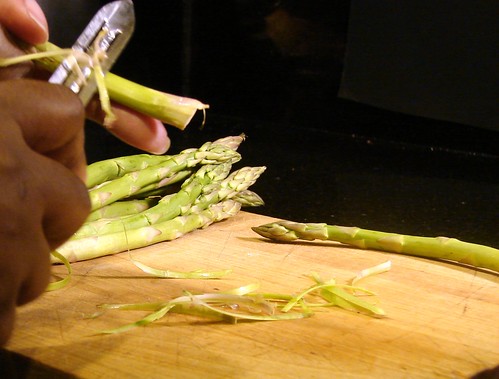
Place the bacon slices on a cutting board and thin it out a bit to make it more pliable.

Divide the asparagus in 4’s. Tuck 4 spears together and lay them on top of a bacon slice. Wrap the bacon around the bottom of the asparagus, then continue rolling the bacon towards the top of the asparagus bundles.
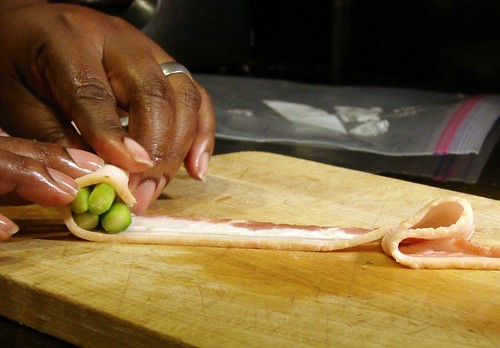
Hubby can tuck the bacon under to secure it… I must admit when he makes these, they’re way prettier than mine. I just use a toothpick and secure the bacon to the asparagus. Repeat this process for the other 3 bundles.
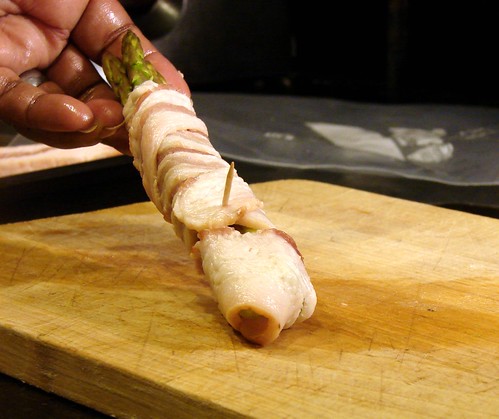
Heat up a skillet–preferably non-stick–over medium high heat and place the bundles about 1-inch apart from each other. Sprinkle with fresh ground pepper. Brown the bacon on all sides, about 2 minutes per side.

Remove from the skillet and set aside. Carefully remove the toothpick before serving. Hubby likes to slice them so they look like sushi.
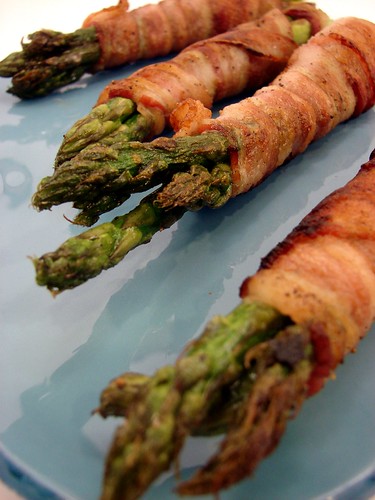
That’s it. Enjoy!
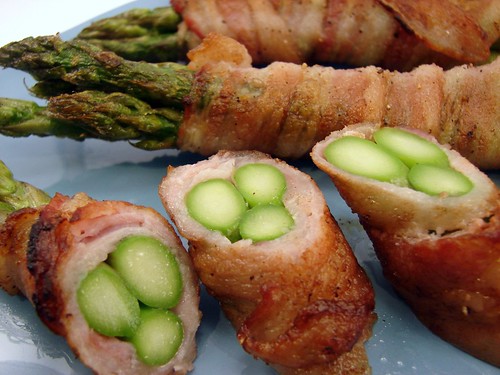
Cookingyly yours,
Anamaris
There’s a reason for it. I will tell you about it this weekend, I hope. I made another chicken breast dish. A few days ago you saw my post for Chicken Cordon Puff. Today I’m sharing my take on a BLT, if you were to sub the L for C and the T for A and you don’t serve it on bread. It is a Bacon Chicken Avocado Roll.
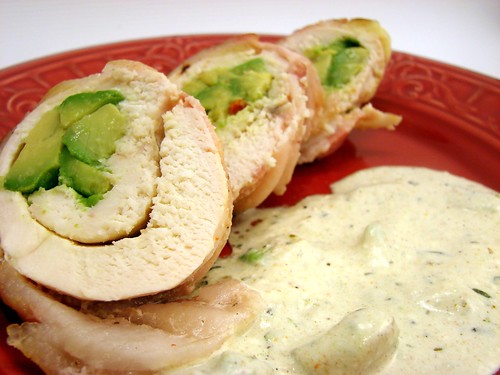
OK, it’s nothing like a BLT, but I did use bacon. Oooh did I use bacon. I hope you like it! If you’ve read previous recipes (you better have been!), you’ll notice that this recipe is almost identical to the process I described for the Chicken Cordon Puff. I decided to include detailed steps here again for your convenience. I hope you don’t mind repetition too much.
I should say that I prepared both recipes the same evening. Getting the chicken breast ready took me less than 1 hour from start to finish. That includes, butterflying, marinating, trussing and stuffing 4 breastesses. Not bad at all, it would probably take about 20 minutes to prepare 2 breasts for either recipe.
Bacon Chicken Avocado Roll
2 chicken breasts, skinless & boneless
1/2 cp Italian dressing (salad dressing)
2-4 slices bacon, thick cut
1 avocado, ripened
Cooking twine or toothpicks
First you will need to butterfly or split the breasts in half and even them out. Place the thickest side of the breast closest to you. Make sure you’re working with a very sharp knife. Place your hand over the breast and guide the knife into the flesh. Your goal is to thin out the breast so that the thickness is all pretty even. Carefully work the knife through the breast, making sure you don’t go all the way through. You’re simply opening up the breast.

Once you’ve finished both breasts, you will need to even out the thickness. The easiest way is to use a ziploc bag large enough to hold one at a time; cut the bag open on one side and the bottom. Lay the breast down on one side of the bag, top it with the other end then use a mallet or a flat heavy pan to flatten the breasts out.

Pound it out a few times, just until it looks even. After that’s done, pour the salad dressing over both breasts, allow them to marinate while you get the other ingredients ready. Set aside for about 15 minutes.
Spread the bacon out and stretch it a bit to make it more pliable. Peel and slice the avocado into thin strips. It’s time to assemble the roll. Spread out the breast on your cutting board and place a few slices of avocado on one end of it.
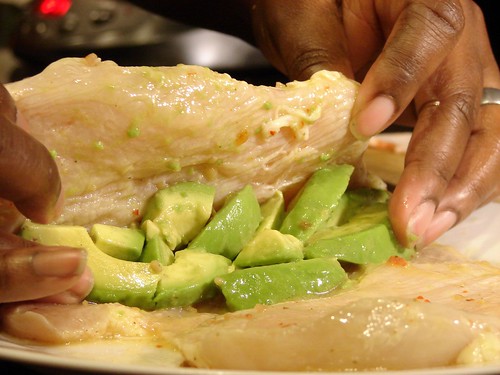
Make sure you’re rolling it tightly and tucking any straggling ends towards the center. Next, roll it in the bacon. Start at one end and work yourself towards the center. Then start the second slice from the opposite end and again work towards the center.
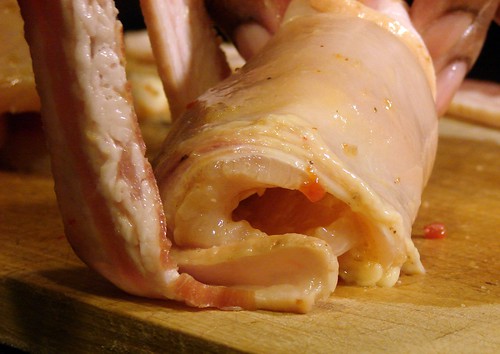
Once you’ve stuffed and rolled, you’re ready for some trussing!
First, take the longest piece of twine and slide it under the trussee. Bring it to the top, pull towards one of the ends and tie 2 knots. Make sure to pull it taut, but not too tight.
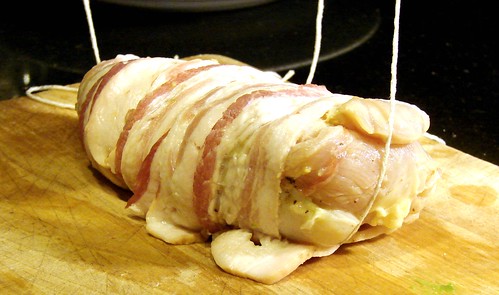
Next, you will need to knot the cross-sections. Take another piece of twine and slide it under to about 1-inch from the center tie. Pull up, double knot. Repeat this step for as many sections as you need. The chicken breast I rolled for this demonstration was about 7, maybe 8 inches long. I tied it twice on either side of the center cross-section.
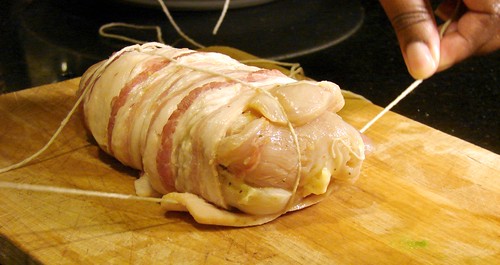
Make sure to trim the twine before you put it in the oven.
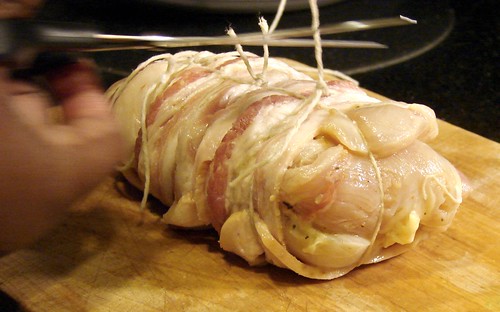
Preheat oven to 400. For step-by-step trussing instructions, follow the link. Place the finished breasts on a baking sheet lined with parchment paper and bake for 15-20 minutes or until the bacon is golden. Remove from the oven and allow it to rest for 5 minutes before cutting away the twine.
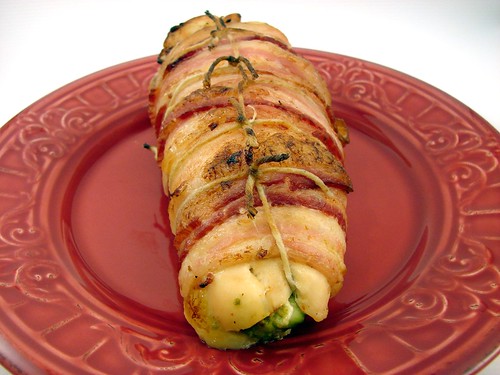
I made a quick cream sauce to serve with it. In a small pan I mixed
1/2 cp sour cream
1/2 cp milk
1/4 tsp Herbs d’Provence
2 slices avocado, diced
Dash of cayenne pepper (to taste)
Dash of salt
Stir all the ingredients over low heat, just long enough for sour cream to melt.
Slice the roll before serving.
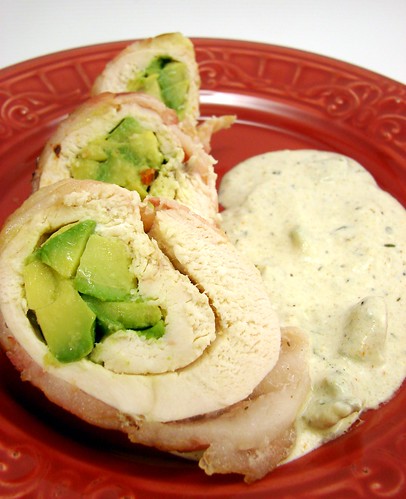
Cookingly yours,
Anamaris

You heard it here first, hopefully. The Top Chef It Yourself first challenge ended a few days ago and you voted for your favorite ‘getting to know you’ recipe.
Casey from Eating, Gardening & Living in Bulgaria won you over with her version of a Lavender Creme Brulee. Give her a round of applause as I bestow upon her the TCIY badge for the month!
I’m sure you would like to know more about Casey, so I took the liberty of asking her a few questions. Read what she has to say.
When did your fascination with cooking begin? Tell us what got you started.
My fascination with cooking has existed for some time now. My parents aren’t really culinarily inclined, so almost every year we would go to my Aunt’s house, who is very Martha Stewart-esque. She introduced me to the joys of pie making, so the first thing I learned was how to bake pies and cookies. It wasn’t until I moved to Bulgaria that I really started to cook regularly and experiment with more complicated dishes. Being from New York, I quickly got bored with only have Bulgarian cuisine. I wanted variety, so I worked on replicating things I missed from home.
Kyust-whaat? How does a NY girl end up in Bulgaria?
I ended up in Kyustendil because this is where my husband’s family lives and we moved here to be closer to them as they are getting on in years. I am not going to say it was an easy adjustment, but I do like living here. Everyday is an adventure and that is the attitude that I try to keep.
What have you learned about cooking, growing and living in Bulgaria?
Bulgaria has taught me the value of fresh ingredients and seasonal eating. In the US, we are spoiled by the fact that we can eat what we want when we want. Produce here is only available till it is gone. In the spring you have lettuce and you eat lettuce for two months, then no more lettuce. Plus, there was just one variety, green leaf lettuce, no mixed greens to be found, which was hard to adjust to. Trips to the grocery store were very frustrating. So, I bought some seeds and made my own garden, dedicated to growing what I wanted, so for the past 3 years, I have been exploring gardening as a way to bring my cooking to the next level.
Tell us about an ingredient you don’t like to cook with
I avoid cooking with offal. I just don’t like it! I am adventurous enough that I don’t need offal in my repertoire.
Do you have any suggestions for variations to your Creme Brulee?
Creme brulee is like a blank canvas… you can infuse it with anything. Next up, I have some jasmine blossoms, which are itching to become a dessert. I will keep you all posted on my success!
Aside from yours, tell us which 2 dishes submitted by the other participants you’re most likely to prepare.
All the other entries sounded delicious, but I love custard based desserts so, Jan’s
Choco-Kahlua Flan is right up my alley. Second, Kitchen Masochist
Purple Yam Cardamom Cheesecake is such a bizarre creation that I am willing to hunt down the ingredients to try it!
Doesn’t she sound just awesome? Casey didn’t mention this, but she is currently working/training as a chef at the Hilton Hotel in Sofia, Bulgaria, while juggling her love of food and gardening.
Again, I would like to thank all the participants for January’s challenge and invite you once again to check out the
entries. Remember we will have a new set of ingredients for February, so stay tuned!
I should start by admitting my addiction to puff pastry. It’s true. My name is Anamaris and I’m a Puff Pastry Addict. There. I feel better already. Mind you. I don’t think I’ll EVER attempt making my own puff pastry (knocks on wood, throws salt over shoulder). I love homemade, but I just don’t think I can make it for less than what it costs me at the store. I’m sorry, Martha.
Pre-packaged puff pastry is God’s gift to harried hostesses. It was conceived for people who love flaky things, but don’t have the time or skill to make it themselves. Yet, they long to whip up a batch of something delicious, pull it out of their ovens with a flourish and impress their guests. Oooohs and Aaaahs ensue. Cue the violins and chirping birds. Sorry.
Anydoo, how better to impress that special someone in your life on V-day than with a dish that looks like you slaved all day over a hot stove and a hotter oven? Hmm? Hmm? I bring you a twist on traditional Chicken Cordon Bleu. I present for your consideration…

Chicken Cordon Puff
2 chicken breasts, skinless & boneless
1/2 cp Italian dressing (salad dressing)
2-4 slices bacon, thick cut
3 ozs Gouda cheese, or your choice
1 sheet of puff pastry, thawed
1 egg, beaten
First you will need to butterfly or split the breasts in half and even them out. Place the thickest side of the breast closest to you. Make sure you’re working with a very sharp knife. Place your hand over the breast and guide the knife into the flesh. Your goal is to thin out the breast so that the thickness is all pretty even. Carefully work the knife through the breast, making sure you don’t go all the way through. You’re simply opening up the breast.

Once you’ve finished both breasts, you will need to even out the thickness. The easiest way is to use a ziploc bag large enough to hold one at a time; cut the bag open on one side and the bottom. Lay the breast down on one side of the bag, top it with the other end then use a mallet or a flat heavy pan to flatten the breasts out.
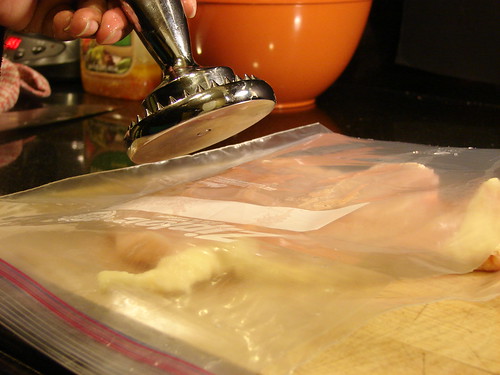
Pound it out a few times, just until it looks even. After that’s done, pour the salad dressing over both breasts, allow them to marinate while you get the other ingredients ready. Set aside.

Stretch out your bacon slices. Depending on the size of the breasts you will need 2 or 3 slices of bacon to roll each one. I used 2 for mine. Slice the cheese into 1-inch wide strips, long enough to go the length of the breast. Set aside.
Time to assemble it. Spread out the breast on your counter and place 1 slice of cheese each on one end of it.
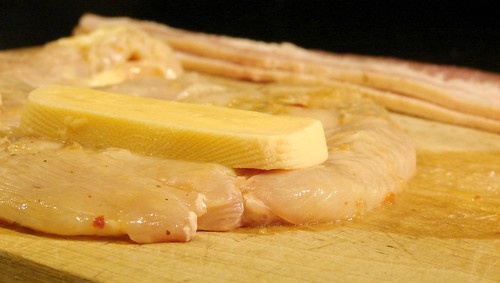
Now roll it tightly, tucking any straggling ends towards the center.
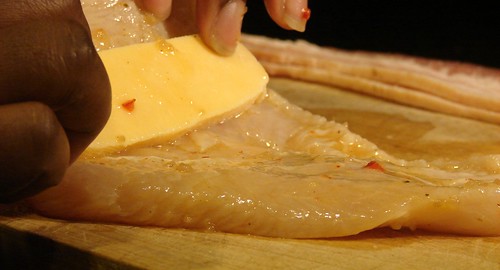
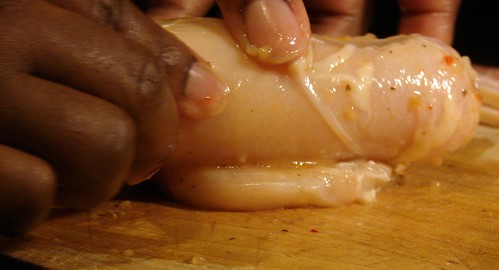
Next, roll it in the bacon. Start at one end and work yourself towards the center. Then start the second slice from the opposite end and again work towards the center.

Set aside when done.
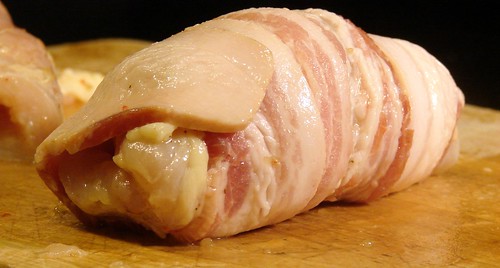
Line a baking sheet with parchment paper and set aside. Remove 1 sheet of the pastry and spread on a cutting board. When you open the package, you will notice that the sheet is folded in thirds lengthwise. Cut the sheet in half across the thirds. Stretch the pastry out a bit; be careful not to pull on the folds. Instead, pull between the folded sections.
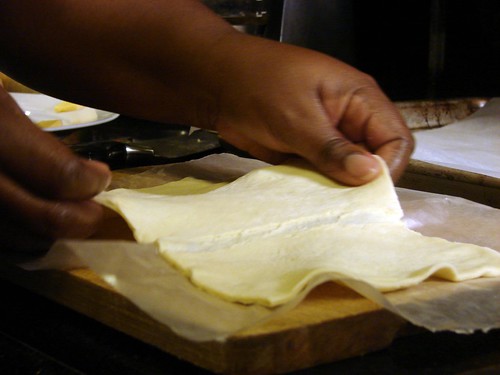
Place one of the bacon-wrapped breasts on one end of the pastry and roll it to the other end. Try tucking in the sides as you roll it. Once you get to the end, pinch the seams and try to have all the seams at the bottom of the roll. Place it on the baking sheet and repeat with the other one.
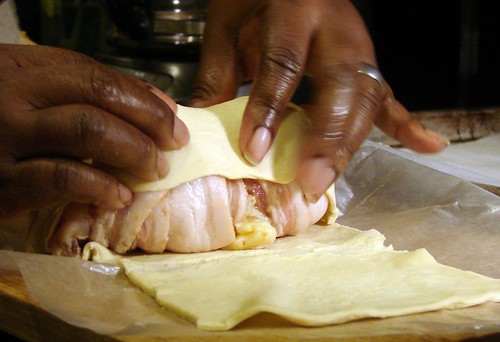
Brush the tops and sides of both bundles with the beaten egg. Using a sharp knife, score the tops of each roll. You can get creative here. Just make sure 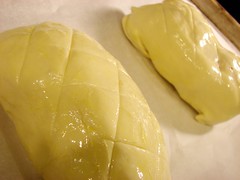 there are a couple of scores deep enough to go all the way through to the bacon. This will allow the contents to breathe without making the puff pastry go POOF!
there are a couple of scores deep enough to go all the way through to the bacon. This will allow the contents to breathe without making the puff pastry go POOF!
Pop them into the freezer or fridge while the oven preheats. Preheat oven to 400°.
Bake them for 15 or until golden brown. Remove from the oven and allow them to rest for 5 minutes before cutting into them.
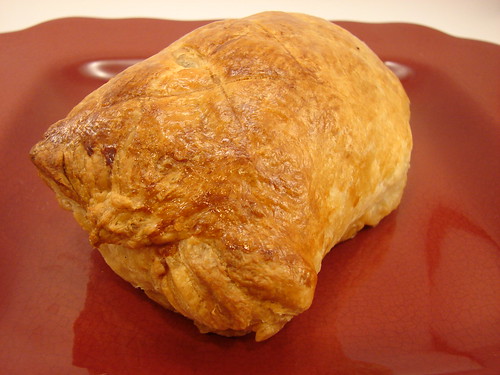
Slice before serving. Voila!
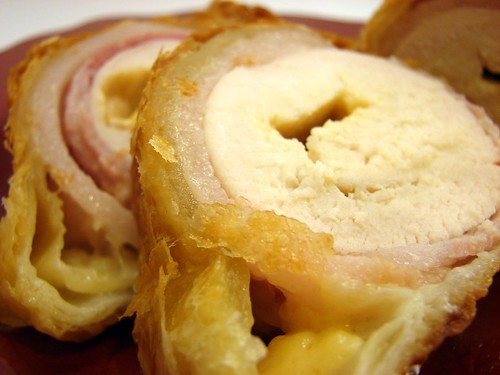
Cookingly yours, Anamaris


























































 there are a couple of scores deep enough to go all the way through to the bacon. This will allow the contents to breathe without making the puff pastry go POOF!
there are a couple of scores deep enough to go all the way through to the bacon. This will allow the contents to breathe without making the puff pastry go POOF!
